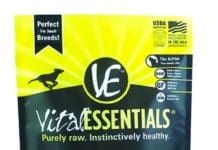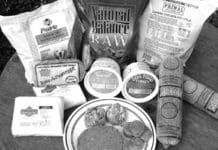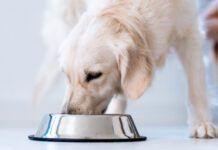Home Search
raw - search results
If you're not happy with the results, please do another search
Raw Dog Food and Salmonella Risks
Thanks to dogs' industrial-strength digestive systems, their strong stomach acids usually disarm the Salmonella bacteria before they can cause illness. And even if enough of the bacteria survive and manage to take up residence in the dog's digestive tract, he may well be completely asymptomatic; not all canine carriers of Salmonella become ill. This makes it difficult to know how widespread Salmonella infections are in the canine population.
High Pressure Processing in Raw Dog Food
Were you aware that, according to Federal law, it's okay for a certain percentage of the chicken you buy in the supermarket to contain some Salmonella bacteria? The legally acceptable amount depends on the kind of chicken we're talking about; if we're talking about whole raw broiler chickens, up to 9.8 percent could be infected, but if we're considering raw chicken parts, the number is even higher. In fact, up to 15.4 percent of the raw chicken parts may contain that pathogenic bacteria, without setting off any sort of recall or hysteria. In contrast, even a single positive test for Salmonella in raw dog food triggers a recall and headlines and a certain amount of hysteria among dog owners. What gives?
The State of the Commercial Raw Diet Industry
Three of the most knowledgeable and experienced advocates of well-formulated raw diets for dogs have joined forces to explain how to evaluate commercial raw diets. We described them in the inaugural installment of this column last month: Dr. Karen Becker, a leading holistic veterinarian; Steve Brown, one of the founders of this industry; and Mary Straus, one of the most dedicated canine nutrition researchers and writers. This month, we've asked them to address the state of the commercial raw diet industry, starting with diets that are labeled as complete and balanced" or "AAFCO-compliant" (formulated to meet the nutritional levels established by the Association of American Feed Control Officials).Their executive summary? More and more dog owners and veterinarians are learning that well-formulated raw diets are the best food for most dogs most of the time but the commercial raw dog food industry has problems. They are disappointed with the apparent lack of basic nutritional knowledge demonstrated by many companies as evidenced by the formulation of their products despite the manufacturers' good intentions.They hasten to add
The Nutritional Adequacy of Raw Food Diets
Research is needed to analyze the nutritional adequacy of raw food diets. However, a published study didn’t accomplish that goal. The Journal of the American Veterinary Medical Association (JAVMA) published an article written by two veterinarians about homemade and commercially made raw meat-based diets. (A similar article, based on the same data, was published in the AKC Gazette.) The article has been regarded by many proponents of homemade diets as a warning shot fired by the commercial-food -producing community and their traditional veterinary medical footsoldiers over the bow of the raw feeding ship.
Feeding Raw Bones
Bones are usually the issue that sticks in the craw of many people who are thinking of feeding their dogs according to the diet plan called BARF, a humorous acronym for bones and raw foods
Raw Meat-Based Dog Food Diets
There are some very high-profile illnesses that can result from handling raw meat – scarifying things like E. coli, salmonella, and trichinella. The mere idea of these threats prevents many people interested in “raw feeding” from giving this type of highly beneficial diet a try. So, we’re going to demystify everything that could go wrong with raw meat (but probably won’t). We’ll describe some horrible diseases, and how they would affect a person who got them, and how they would affect a dog.
Frozen Raw Meat Diets for Dogs
About frozen raw meat diets for dogs: We’ve got some good news, and some bad news. Here’s the good news: raw meat-based diets are really “what’s best” for dogs. With their sharp, tearing teeth, jaws capable of crushing bones, and short, highly acidic digestive systems, dogs are made to eat and thrive on diets that are made mostly of meat and bones. Every holistic veterinarian we know suggests feeding a raw meat-based diet, both to improve a dog’s existing health, or to recover it. Vital amino acids and food enzymes, vital for superior digestion and nutrient absorption, are present in raw meat, and survive the freezing/defrosting process beautifully.
Dog Breeders Who Only Feed Raw Dog Food Diets
You know you’ve been feeding raw for a long time when it no longer seems like a radical, ground-breaking, or – ubiquitous adjective for beginners – scary way to feed. When I started feeding raw – a dozen years and three generations of Rhodesian Ridgebacks ago – it was the Middle Ages of raw feeding. Ian Billinghurst’s Feed Your Dog a Bone was the hard-to-find illuminated manuscript (the lax editing could have stood some sprucing up by Benedictine monks), and everyone used the unfortunate acronym BARF, which stood for “bones and raw food” (or, later, the loftier-sounding “biologically appropriate raw food”). No commercial raw diets were available, and new converts dutifully ordered their Maverick sausage grinders over the Internet. The instruction booklet said the table-top grinder couldn’t be used on any bones harder than chicken necks or wings, but everyone ignored that.
Freeze-Dried Raw Dog Foods: What You Need To Know
Most of the ingredients in freeze-dried diets are raw and/or very lightly processed. All the freeze-dried raw diets we reviewed are grain-free not because we think grains are inappropriate in these foods; it's the food manufacturers who seem to have decided that raw feeders won't buy a product that contains any grain. Many people who feed home-prepared or commercial raw diets to their dogs when they are home replace this diet with a freeze-dried raw food when they travel, or when the dog is left with a sitter who doesn't want to deal with a fresh or frozen raw diet.
Feeding a Raw Dog Food Diet Takes Experience
Many of us would like to feed our dogs a biologically appropriate raw diet, but lack the time and experience to ensure that the menu is complete and balanced. Frozen commercial diets are the answer. Despite what many makers of conventional canned or dry pet foods would have you believe, raw diets for dogs are not a modern fad, but a return to the dog’s not-so-distant past.
Beef and Brown Rice Homemade Dog Food Recipe
Providing a balanced, home-cooked diet for your dog doesn't have to be complicated! This simple yet nutritionally complete beef and brown rice recipe follows NRC guidelines for adult maintenance and uses ingredients readily available at most supermarkets.
Can Dogs Get Bird Flu?
Bird flu is making the news a lot lately, and you may wonder if dogs can catch bird flu. Also called avian flu or referred to as H5N1, this virus has the potential to expand its horizons beyond birds to humans and other mammals. As of this writing, no dogs have become clinically ill or died from this recent strain of H5N1 bird flu.













